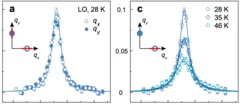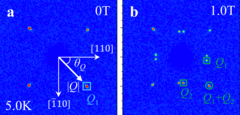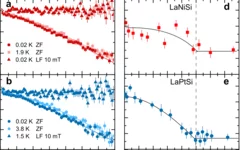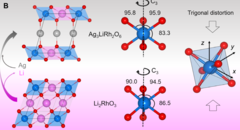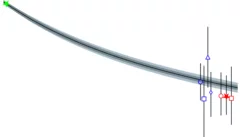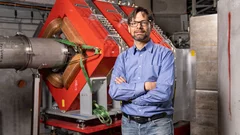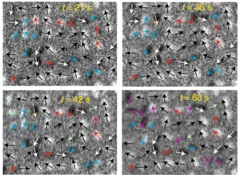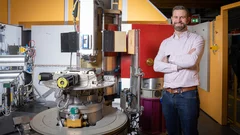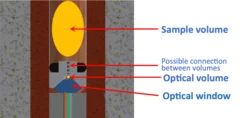NUM division - Publication Highlights
Uniaxial pressure induced stripe order rotation in La1.88Sr0.12CuO4
Static stripe order is detrimental to superconductivity. Yet, it has been proposed that transverse stripe fluctuations may enhance the inter-stripe Josephson coupling and thus promote superconductivity. Direct experimental studies of stripe dynamics, however, remain difficult. From a strong-coupling perspective, transverse stripe fluctuations are realized in the form of dynamic “kinks”—sideways shifting stripe sections. Here, we show how modest uniaxial pressure tuning reorganizes directional kink alignment.
Square and rhombic lattices of magnetic skyrmions in a centrosymmetric binary compound
Magnetic skyrmions are topologically stable swirling spin textures with particle-like char- acter, and have been intensively studied as a candidate of high-density information bit. While magnetic skyrmions were originally discovered in noncentrosymmetric systems with Dzyaloshinskii-Moriya interaction, recently a nanometric skyrmion lattice has also been reported for centrosymmetric rare-earth compounds, such as Gd2PdSi3 and GdRu2Si2. For the latter systems, a distinct skyrmion formation mechanism mediated by itinerant electrons has been proposed, and the search of a simpler model system allowing for a better understanding of their intricate magnetic phase diagram is highly demanded. Here, we report the discovery of square and rhombic lattices of nanometric skyrmions in a centrosymmetric binary compound EuAl4, by performing small-angle neutron and resonant elastic X-ray scattering experiments.
Spin-triplet superconductivity in Weyl nodal-line semimetals
Topological semimetals are three dimensional materials with symmetry-protected massless bulk excitations. As a special case, Weyl nodal-line semimetals are realized in materials having either no inversion or broken time-reversal symmetry and feature bulk nodal lines. The 111-family, including LaNiSi, LaPtSi and LaPtGe materials (all lacking inversion symmetry), belongs to this class. Here, by combining muon-spin rotation and relaxation with thermodynamic measurements, we find that these materials exhibit a fully- gapped superconducting ground state, while spontaneously breaking time-reversal symmetry at the superconducting transition.
First demonstration of tuning between the Kitaev and Ising limits in a honeycomb lattice
Recent observations of novel spin-orbit coupled states have generated interest in 4d/5d transition metal systems. A prime example is the Jeff = 1/2 state in iridate materials and α-RuCl that drives Kitaev interactions. Here, by tuning the competition between spin-orbit interaction (λSOC) and trigonal crystal field (ΔT), we restructure the spin-orbital wave functions into a previously unobserved μ=1/2 state that drives Ising interactions.
The Running Bottom Quark Mass and the Higgs Boson
We present a new measurement of the bottom quark mass in the MS scheme at the renormalization scale of the Higgs boson mass from measurements of Higgs boson decay rates at the LHC: mb (mH) = 2.6 +0.36-0.31 GeV. The measurement has a negligible theory uncertainty and excellent prospects to improve at the HL-LHC and a future Higgs factory.
Two million Swiss francs granted to search for new physics
Philipp Schmidt-Wellenburg will set up a novel experiment at a muon beamline at PSI.
Direct observation of a dynamical glass transition in a nanomagnetic artificial Hopfield network
Spin glasses, generally defined as disordered systems with randomized competing interactions, are a widely investigated complex system. Theoretical models describing spin glasses are broadly used in other complex systems, such as those describing brain function, error-correcting codes or stock-market dynamics. This wide interest in spin glasses provides strong motivation to generate an artificial spin glass within the framework of artificial spin ice systems. Here we present the experimental realization of an artificial spin glass consisting of dipolar coupled single-domain Ising-type nanomagnets arranged onto an interaction network that replicates the aspects of a Hopfield neural network.
Waves on circular paths
Just as electrons flow through an electrical conductor, magnetic excitations can travel through certain materials. Such excitations, known in physics as "magnons" in analogy to the electron, could transport information much more easily than electrical conductors. An international research team has now made an important discovery on the way towards such components, which could be highly energy-efficient and considerably smaller.
Optical Setup for a Piston-Cylinder Pressure Cell: A Two-Volume Approach
Measurement of the absolute value of the applied pressure in high-pressure muon and neutron experiments is a complicated task. It often requires the presence of a calibration material inside the sample volume, and could also cause additional time to obtain the response of the calibrant. Here we describe the use of optical calibrants for precise determination of the pressure value inside the piston-cylinder clamp cells.
